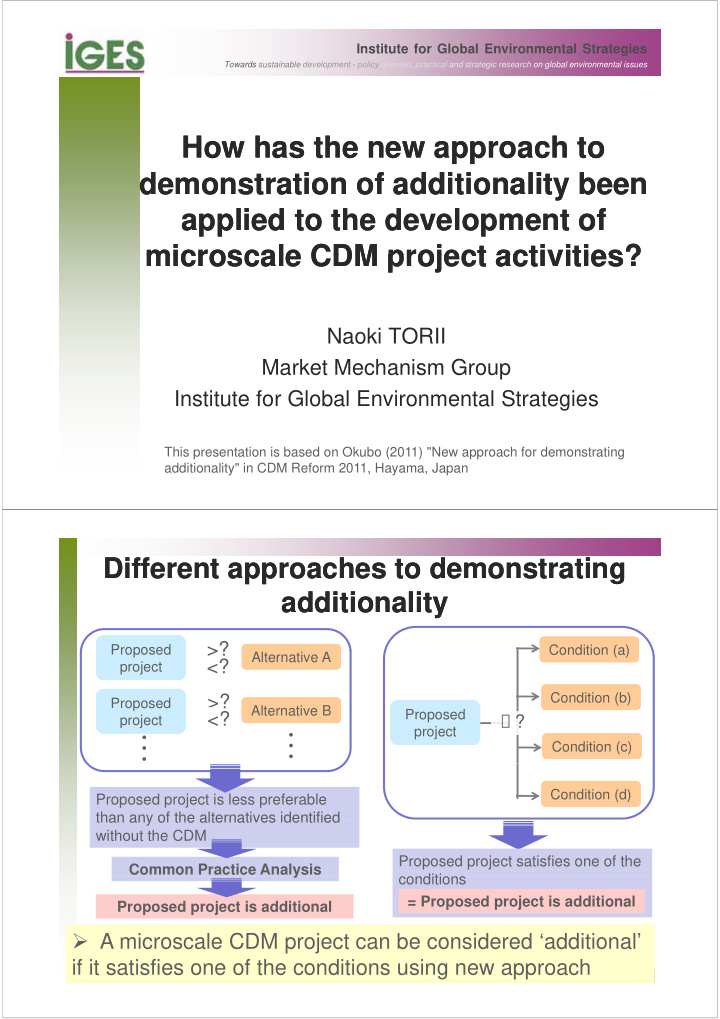



Institute for Global Environmental Strategies Towards sustainable development - policy oriented, practical and strategic research on global environmental issues How has the new approach to How has the new approach to How has the new approach to How has the new approach to demonstration of demonstration of additionality additionality been y been applied to the development of applied to the development of microscale microscale CDM project activities? microscale microscale CDM project activities? CDM project activities? CDM project activities? Naoki TORII Market Mechanism Group Market Mechanism Group Institute for Global Environmental Strategies This presentation is based on Okubo (2011) "New approach for demonstrating additionality" in CDM Reform 2011, Hayama, Japan Different approaches to demonstrating Different approaches to demonstrating additionality additionality dditi dditi lit lit >? >? Proposed Proposed Proposed Proposed Condition (a) Condition (a) Condition (a) Condition (a) Alternative A Alternative A <? project project Condition (b) Condition (b) >? ? Proposed Proposed Proposed Proposed Alternative B Alternative B Alt Alt ti ti B B Proposed Proposed ○ ? <? project project ・ ・ project project ・ ・ Condition (c) Condition (c) ・ ・ Condition (d) Condition (d) Proposed project is less preferable than any of the alternatives identified than any of the alternatives identified without the CDM Proposed project satisfies one of the Common Practice Analysis y conditions diti = Proposed project is additional Proposed project is additional A microscale CDM project can be considered ‘additional’ if it satisfies one of the conditions using new approach 1
Microscale Microscale CDM CDM projects registered before projects registered before the adoption of the guidelines (registration) the adoption of the guidelines (registration) the adoption of the guidelines (registration) the adoption of the guidelines (registration) By project type By project type By host country By host country =5 projects =5 projects Total: 253 (from 2004 – May 28, 2010 ) May 28 2010 ) (from 2004 Source: IGES CDM Database as of 1 Aug. 2011 Some microscale projects of common types (e.g. grid- p j yp ( g g connect power generation) have already emerged in major CDM host countries, but few have appeared in LDCs 2 Status of Status of microscale microscale CDM project development CDM project development using the guidelines using the guidelines using the guidelines using the guidelines Host country Host country Project type Project type Num. Num. Non- Hydro power 8 China LDC • The projects that has Solar thermal 1 Hydro power Hydro power 3 3 entered validation using t d lid ti i Viet Nam Biogas power 1 the guidelines: 30 (from Wind power 2 India 29 May 2010 to1 August 29 May 2010 to1 August Photovoltaic (PV) 2 2011) Guatemala Hydro power 2 Republic of Korea Hydro power 1 • 3 of them have been 3 of them have been Chile Hydro power 1 registered Thailand Biomass power 1 • In LDCs, development of In LDCs, development of Th The Philippines Phili i Bi Biogas power 1 1 7 projects had started in LDC Cambodia Biogas power 1 about a year using the Madagascar Photovoltaic (PV) 1 guidelines Rwanda Other renewable 1 Uganda Biomass power 1 Microscale project p j Hydro power Hydro power 1 1 development has significantly Tanzania Biomass power 1 increased in LDC Zambia Hydro power 1
Number of Number of microscale microscale CDM projects under CDM projects under validation by condition satisfied validation by condition satisfied validation by condition satisfied validation by condition satisfied Source: IGES CDM Database as of 1 Aug. 2011, PDD of each project The condition that the project is in underdeveloped zone is p j p most used but the definition of and data to prove “underdeveloped” varies depending on a project or host country 4 Potential influences of the guidelines on Potential influences of the guidelines on microscale microscale project development microscale microscale project development project development project development Number of reviewed and rejected microscale projects by category of reason Number of reviewed and rejected microscale projects by category of reason • In LDCs: No review or Reasons related to additionality rejection. Microscale project development has project development has been hindered • In non-LDCs: d demonstration of t ti f additionality, particularly 0 0 through investment g analysis has been a major reason for review/ rejection rejection Source: IGES CDM Review and Rejected Project Database as of 1 Aug. 2011 The guidelines are likely to promote microscale project g y p p j development by removing a barrier of additionality demonstration or reducing review/rejection related to its process 5
Issues to be addressed for Issues to be addressed for improvements of the guidelines improvements of the guidelines • The guidelines should provide as much certainty of • The guidelines should provide as much certainty of passing the additionality test as possible to simplify the process the process Indicators and their values to prove “underdeveloped zone” underdeveloped zone Clear guidance for host countries about “technologies/measures recommended by host “t h l i / d d b h t country” Appropriateness of “technologies or measures with a total installed capacity of less than or equal to 5% to national annual electricity generation 6
Recommend
More recommend